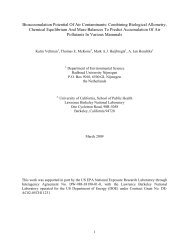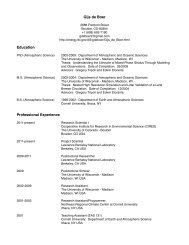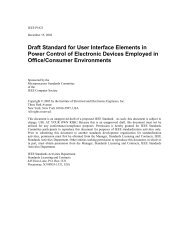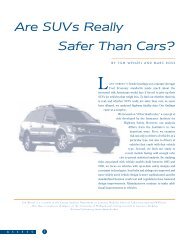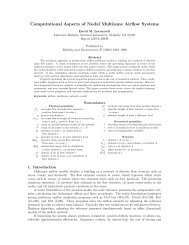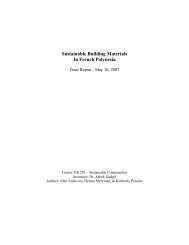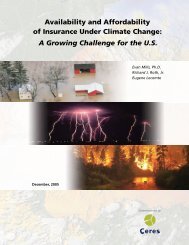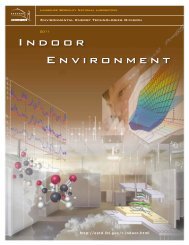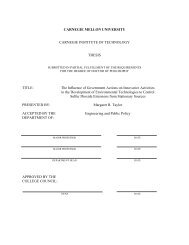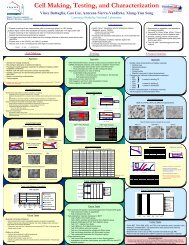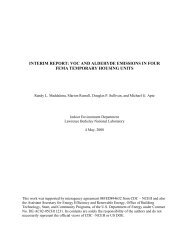indoor-outdoor air leakage of apartments and commercial buildings
indoor-outdoor air leakage of apartments and commercial buildings
indoor-outdoor air leakage of apartments and commercial buildings
You also want an ePaper? Increase the reach of your titles
YUMPU automatically turns print PDFs into web optimized ePapers that Google loves.
Before discussing the analysis, we present the raw data in more detail. Figures 5 <strong>and</strong> 6<br />
display the building leakiness data, by function <strong>and</strong> construction type (similarly to Figure 2 <strong>and</strong><br />
Figure 3), but now using plotting symbols that distinguish the <strong>buildings</strong> by height <strong>and</strong> by<br />
footprint area. From visual inspection, there is little evidence <strong>of</strong> a substantial relationship<br />
between height <strong>and</strong> <strong>leakage</strong>, footprint <strong>and</strong> <strong>leakage</strong>, or building age (or year built) <strong>and</strong> <strong>leakage</strong><br />
(see Figure 8). Nevertheless, in addition to building categories we included footprint <strong>and</strong> height<br />
categories in the statistical analyses.<br />
Our main results, discussed below, concern multivariate analyses that consider all <strong>of</strong> the<br />
available explanatory variables together, but we also performed some univariate comparisons:<br />
1. For <strong>buildings</strong> with footprint area greater than or equal to 1000 square meters<br />
(n=107), the geometric mean flow rate at 50 Pa was 4.5 L per second per square·<br />
meter <strong>of</strong> building shell. For <strong>buildings</strong> with footprint area less than 1000 square<br />
meters (n=160) the geometric mean flow rate at 50 Pa was 2.6 L per second per<br />
square meter <strong>of</strong> building shell.<br />
2. For <strong>buildings</strong> with 5 or more floors (n=26), the geometric mean flow rate at 50 Pa<br />
was 3.3 L per second per square meter <strong>of</strong> building shell. For <strong>buildings</strong> with fewer<br />
than 5 floors (n=241), the geometric mean flow rate at 50 Pa was approximately<br />
the same, 3.7 L per second per square meter <strong>of</strong> building shell.<br />
3. For <strong>buildings</strong> built in 1986 or later (n=131), the geometric mean flow rate at 50 Pa<br />
was 3.8 L per second per square meter <strong>of</strong> building shell. For <strong>buildings</strong> built<br />
before 1986 (n=136), the geometric mean flow rate at 50 Pa was approximately<br />
the same, 3.5 L per second per square meter <strong>of</strong> building shell.<br />
Multivariate analyses (i.e. including more than one explanatory variable at a time)<br />
suggest that there may be effects associated with building footprint <strong>and</strong> height, but in no case<br />
did the parameters associated with building age indicate the presence <strong>of</strong> a substantial building<br />
age effect, so we excluded age from our main analysis. The lack <strong>of</strong> evidence for an effect related<br />
to building age may be surprising, given that new single-family homes have become much<br />
more <strong>air</strong>-tight over the past twenty years (Chan et al. 2005). However, there is little reason to<br />
believe that <strong>air</strong>tightness in <strong>commercial</strong> <strong>buildings</strong> must increase just because single-family<br />
residential <strong>air</strong>tightness increases: first, construction techniques for most <strong>commercial</strong> <strong>buildings</strong><br />
are very different from those for houses, <strong>and</strong> second, cost-conscious homebuyers have more<br />
incentive to save than do cost-conscious business owners since less than 1% <strong>of</strong> a typical<br />
company's payroll is spent on heating <strong>and</strong> cooling. Persily (1999) has previously noted that<br />
although many researchers <strong>and</strong> laypeople, assume that <strong>commercial</strong> <strong>buildings</strong> have become more<br />
<strong>air</strong>tight in recent years, there is no evidence that this is true. Our analysis suggests that, as<br />
Persily suggests, <strong>commercial</strong> <strong>buildings</strong> from the 1990s are about the same, in terms <strong>of</strong> leakiness,<br />
as those from earlier decades. Effects related to building age could also be difficult to interpret<br />
to a variety <strong>of</strong> effects such as changes in leakiness (or mechanical ventilation rates) due to<br />
renovations; shell or duct <strong>leakage</strong> that change with time due to degradation <strong>of</strong> caulking or duct<br />
tape (an effect that might depend on both building design <strong>and</strong> construction details), <strong>and</strong> so on.<br />
24



